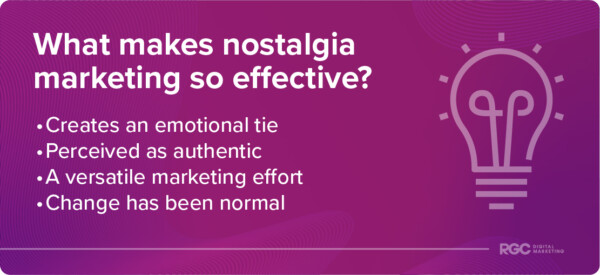Unleashing the Power of Memory: Nostalgia Marketing Takes Centre Stage in 2024

Table of Contents
- But Why Do We Care About Nostalgia In 2024?
- Emotional Investment
- An Authentic Approach
- Versatility
- Rapid Change Has Become The Norm
- Nostalgia Is Alive And Well In 2024
- But, Proceed With Caution
- Authenticity Is Paramount
- Don’t Sacrifice Your Identity
- Offer Something Unique
- Nostalgia Marketing Continues To Be Crucial In 2024
When times become tough and the future becomes bleak, it’s only natural for us to look back favourably on the “good old days”. We as people have a natural tendency to favour bygone times. Whether it’s an evening of reliving your favourite episodes of Friends or blasting the greatest hits of Queen, there’s something so irresistible about the familiarity and predictability of the past.
Whether we recognise it or not, every social trend that has impacted society has been reflected in the actions and decisions of the most successful businesses, and the popularity of nostalgia has been no exception to this. Back in 2022, we put forth the question of whether nostalgia marketing would stand the test of time as we stepped out of the dark times dominated by the Coronavirus and into a new era.
We questioned whether a potentially prosperous future ahead would turn our thoughts away from the past. Would we cast our minds into the future to consider the possibilities of the coming years? Nostalgia marketing had been successful largely as a result of the trying times we had endured, but as these troubling circumstances eased, it was only natural to consider whether the good old days might lose their shine.
However, as we enter 2024, the rationale behind nostalgia marketing has only been further magnified. As financial struggles continue to dominate the headlines, and budgets are tightened further each day, our rose-tinted view of the past only becomes even more evident. A chance to reminisce back to simpler and happier times of the past has become even more appealing to Australian consumers, and many businesses, such as global giants Burger King and Pepsi, have recognised this with a series of successful nostalgia marketing campaigns.
But Why Do We Care About Nostalgia In 2024?
When the future becomes uncertain or we experience great change, it can make for an uncomfortable time when we cling to familiarity and things that we understand and recognise. It’s a natural human reaction because we all seek clarity, a guiding light that can give us a sense of direction and put us at ease. With its ability to transport us to the past, nostalgia has become a favoured sentiment in these tough and uncertain times.
In the economic landscape of Australia in 2024, where financial struggles have become the norm, the allure of nostalgia has only intensified. Australians face economic hardships every day with inflation always on the rise, and it’s inevitable for us to find solace in looking back at better times.
Nostalgia provides a mental escape from the difficulties of the present, allowing individuals to reminisce about happier and more prosperous periods. In this context, nostalgia marketing has emerged as an effective strategy for businesses to connect with their target audience.

Emotional Investment
Most importantly, nostalgia fosters emotional relationships between businesses and consumers. By tapping into cherished memories and sentimental experiences, nostalgia marketing inspires positive feelings and creates a strong bond with the audience.
Whether it’s through nostalgic visuals, music, or references, businesses can evoke feelings of joy, comfort, and familiarity. These emotional connections drive brand loyalty and encourage consumers to choose products or services that evoke positive nostalgic associations.
An Authentic Approach
Furthermore, nostalgia marketing offers a sense of safety, authenticity, and comfort. In an ever-changing world where technology advances rapidly and societal norms evolve, nostalgia provides a refuge in the familiar. Nostalgic marketing campaigns leverage shared cultural references and commonly experienced moments, allowing consumers to feel a sense of belonging and understanding.
By evoking nostalgia, businesses create an authentic and relatable brand image, fostering trust and loyalty. Consumers gravitate towards brands that offer a sense of reliability and consistency, values that are often associated with nostalgic experiences.
Versatility
Nostalgia marketing is also incredibly versatile. It can transport consumers back to their own cherished past or introduce them to elements of a former era that predate their own experiences. For older generations, nostalgia campaigns that recall familiar cultural touchstones evoke fond memories and create a sense of connection.

Simultaneously, for younger consumers, marketing that draws inspiration from an earlier time can offer a fresh and novel experience. A trend of anemoia has even emerged in younger generations, which describes feelings of nostalgia and longing for a time or place that the individual never lived in or experienced. Ultimately, nostalgia has a universal appeal, transcending generations and demographics, making it a powerful tool for businesses to engage a wide range of consumers.
Rapid Change Has Become The Norm
Furthermore, the concept of the “past” has evolved in today’s fast-paced world. With technology now making the impossible a reality with a constant influx of information, what may be considered nostalgic now can encompass events, trends, or experiences that, in truth, are relatively recent.
The acceleration of time and the overwhelming speed of change in our lives make nostalgia marketing even more relevant and impactful. Consumers find comfort in revisiting recent past experiences that evoke a sense of stability and simplicity amidst the rapid progress of society.
Nostalgia Is Alive And Well In 2024
Above all else, nostalgia has a way of capturing our hearts and transporting us back to iconic moments in history. The ’80s gave us neon leggings, voluminous hair, and the birth of MTV. The ’90s brought us grunge fashion, boy bands, and the era of dial-up internet. Each decade used to have its own unique identity, leaving its own mark on popular culture. But what about 2024? In this era of unparalleled diversity and rapid cultural shifts, the concept of nostalgia takes on a whole new meaning.
In recent years, we’ve seen trends and eras blur more than ever, merging into something truly unique. A fusion of styles has captured the imagination of consumers in 2024, and the idea of a product being ‘outdated’ is simply no longer a reality. Our tendency to favour ‘retro’ items has often seen older products become thrust into the mainstream without any conscious involvement from a brand.
Walk through the Pitt Street Mall of Sydney on a Saturday afternoon, and you’re guaranteed to see at least one classic pair of Adidas Sambas, a shoe launched in the 1940s that has become one of the most sought-after pieces of footwear. Step into any home entertainment retailer, and you’re sure to come across record players and hundreds of vinyl records.

In 2024, the most successful brands are those that prove to be culturally observant, and gaining an in-depth understanding of your target market has never been more crucial than it is today. Nostalgia reigns supreme in the modern day, and brands that can tap into the trends of 2024 and beyond by embracing diversity, celebrating individuality, and bridging the gap between the past and the present will continue to capture the hearts and minds of consumers. In this era of unparalleled creativity and ever-expanding possibilities, nostalgia is alive and well, weaving its way into the fabric of our culture and providing a powerful tool for businesses to forge meaningful connections with their audience.
But, Proceed With Caution
While nostalgia marketing can be a powerful tool, it’s important for businesses to launch these campaigns carefully and with great respect for the evolving social landscape in which we live. Social issues and cultural norms today are different from those of the past, and businesses must be mindful of these differences to avoid potential missteps. What may have been acceptable or celebrated in the past could be seen as insensitive or inappropriate in today’s context.
Authenticity Is Paramount
There is no one consideration in any nostalgic marketing effort that is more important than authenticity. Today’s consumers are generally well-informed and have become increasingly sceptical and discerning, demanding genuine connections from the brands they engage with.

For new brands or those that have only recently undergone a rebranding effort, it can be challenging to tap into nostalgia effectively. Building a nostalgic connection requires a deeper understanding of the target audience and the ability to authentically evoke emotions and memories. It’s crucial for businesses to do their research, understand cultural sensitivities and favoured emotions and feelings, and approach nostalgic marketing with sincerity.
Don’t Sacrifice Your Identity
When brands undergo significant changes in their visual identity or messaging in nostalgic marketing efforts, they do also run the risk of alienating loyal customers who may have a strong emotional connection to the brand’s previous identity. One only needs to consider the Pepsi rebranding effort that centred on a new logo that simply failed to resonate with customers.
Striking a balance between nostalgia and a total revamp is crucial to maintaining brand authenticity and loyalty. Brands should carefully consider how to evolve while still honouring their heritage and the memories associated with their previous iterations.

Offer Something Unique
In addition, nostalgia marketing should not solely rely on past successes or popular culture references. It’s important to incorporate fresh and innovative ideas to ensure the campaign stands out from the crowd. Nostalgia can be a powerful starting point, but businesses should strive to create campaigns that capture the spirit of the past while offering something new and relevant to today’s audience. This blend of nostalgia and innovation allows businesses to tap into the comforting familiarity of the past while remaining relevant to their target market.
Nostalgia Marketing Continues To Be Crucial In 2024
Ultimately, nostalgia marketing has remained an effective and powerful tool in 2024, as it taps into our innate desire to reminisce and take comfort in the familiarity of the past. It offers an emotional connection, authenticity, versatility, and a sense of stability amidst rapid societal changes. However, it requires careful consideration and a deep understanding of the evolving cultural landscape to avoid potential missteps. Authenticity is paramount and businesses must find the right balance between nostalgia and innovation to engage effectively with their audience.
While nostalgia marketing provides a compelling opportunity for businesses, it is important to remember that it’s not a one-size-fits-all solution. The most successful brands today and moving deeper into the 2020’s will be those that understand their audience’s nostalgic sentiments and use this insight to create authentic, innovative, and respectful marketing campaigns that resonate on a deep emotional level. If you’d like to capitalise on the endless possibilities of nostalgia marketing, make sure you seek the advice of a reputable digital marketing agency that has all the experience and expertise to help you succeed.


